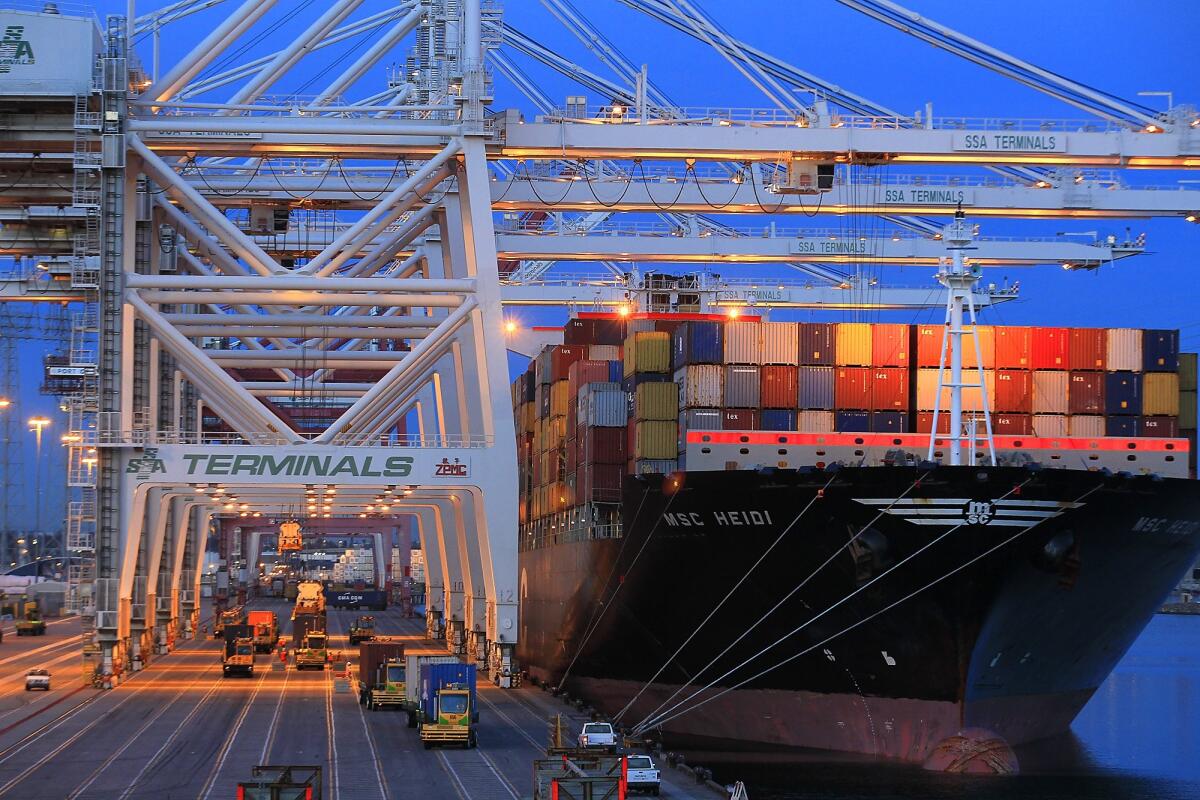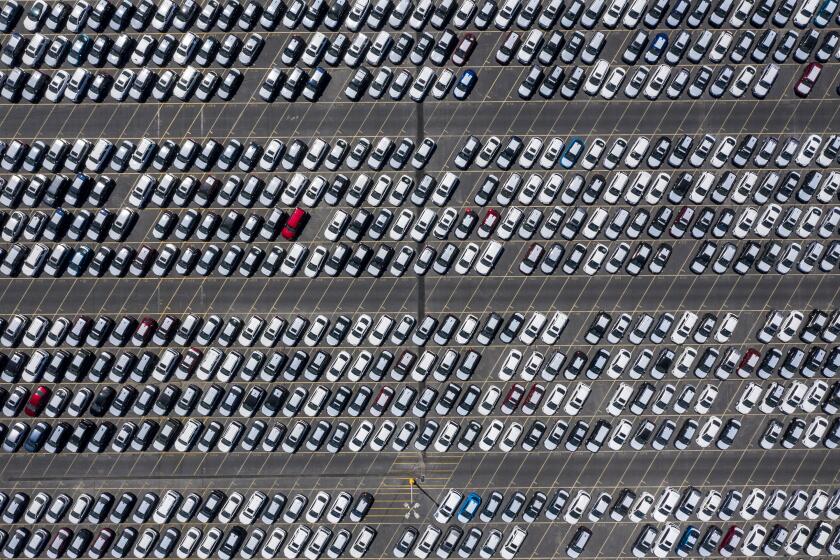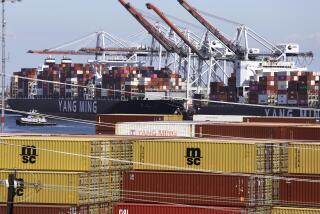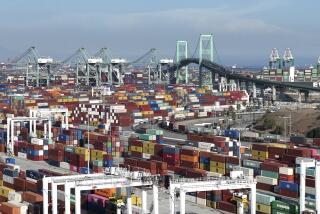Stock investors are getting worried about supply chain

- Share via
Reopening demand and marooned containers have caused bottlenecks across supply chains just as the holiday shopping season kicks off in North America. It’s also prompting downgrades across analyst estimates for the upcoming earnings season.
Few expect the supply problems to end this year as an energy crisis stokes inflation fears. Caution abounds in the semiconductor, retail and raw material sectors.
“The supply-chain problems are going to stay, leading to substantially higher prices and major dislocations in parts of markets no one is expecting,” said George Ball, chairman of Houston investment firm Sanders Morris Harris. “Almost all segments of the economy that are not pure service or pure technology driven will be struggling with supply-chain issues for a long time.”
Many items destined for retailer shelves this holiday season are hopelessly snarled in the global supply chain. What does that mean for shoppers?
Here are some challenges and opportunities identified by investors for key sectors ahead of the earnings season:
Semi snags
For the semiconductor industry, expectations are for more capacity to only trickle in by the latter part of 2022 because of factory closures and longer delivery times. A power crunch in China could also worsen the situation as it shuts down factories.
However, with hubs such as Malaysia reopening, the pricing power of some companies could weaken particularly at a time material costs such as silicon are soaring.
Prices for DRAM and NAND chips already appear to be peaking, and 12-month forward earnings estimates for chipmaking giants Samsung Electronics Co., Micron Technology Inc. and Intel Corp. have fluctuated or fallen in the last two months. Shares are down around 20% or more from recent peaks.
“Even though many of them have had revenues surge to all-time records, the stocks have not followed suit,” Susquehanna analyst Christopher Rolland said. “That tells me that at this point some of this consternation is baked into shares more broadly.”
Auto woes
Chip shortages are also behind the estimated $210 billion in lost sales for carmakers this year. Many have reported a slump in revenues in the third quarter, worsened by shipping logjams and port congestion. However, with the industry’s troubles well documented, some analysts see most of the downside already priced in.
“We see 3Q as likely being the trough in terms of auto production” in the U.S., although there could be multiple guidance cuts by suppliers, Morgan Stanley analysts including Adam Jonas wrote Wednesday. “But production cuts seem well telegraphed, so don’t be surprised to see investors buy the 3Q chip dip.”
The MSCI AC World Automobiles & Components Index has been climbing toward a seven-month relative high against the broader market since late August.
A unique set of circumstances brought on by the pandemic has roiled the used car market, leading to an inventory shortage that has sent prices soaring.
Tesla Inc. and Toyota Motor Corp. appear to be handling the shortages better than others, with the Japanese carmaker reporting a 1.4% increase in sales in the latest quarter.
“Toyota has managed their chip supply very well so far” because they’ve been addressing supplier relationships differently after an earthquake earlier this year halted production, said Tineke Frikkee, head of British equity research at Waverton Investment Management.
Retail trouble
A 66% plunge in bellwether Bed Bath & Beyond Inc. shares since early June exemplifies the problems facing retailers globally, with multiple choke points in their supply chains just as they need to stock up for the most important time of the year. A gauge of the sector is trailing the broader market by more than 7 percentage points this half, as companies cut forecasts for sales and profitability.
The challenges will modestly affect margins for the third quarter and have a more significant effect in the next, which captures the holiday season, said Telsey Advisory Group analyst Cristina Fernandez.
Making matters worse are factory closures. Nike Inc. lowered its sales forecast in late September because of shutdowns in Vietnam, where tens of thousands of workers are now leaving the factory heartland. Deckers Outdoor Corp., Skechers USA Inc., Adidas and Under Armour Inc. also have at least a quarter of their production in Vietnam, Wedbush Securities analyst Tom Nikic said.
“That said, the most-exposed stocks are down 20% on average since mid-August, so we think investors have digested most of these issues,” Nikic wrote in a note last week.
Raw pain
What’s making matters worse for margins is a supply crunch within the commodity sector, driving raw material costs even higher for businesses already dealing with logistics issues.
“The next supply-and-demand disruption is on the energy front,” said Zhikai Chen, head of Asian equities at BNP Paribas Asset Management. “We may see further supply issues if energy rationing becomes more widespread.”
Citigroup’s Global Earnings Revision Index, a worldwide measure of analyst upgrades minus downgrades of profit expectations, is plummeting toward negative territory after hitting an all-time high in May.
Cotton climbed near a fresh decade high Thursday, while decarbonization policies in China and India have led to an acute coal crunch, and Europe’s natural gas prices are skyrocketing.
Still, energy shortages and high oil prices should be a positive for green energy producers, electric vehicles, the battery industry and the entire green energy supply chain, said Willem Sels, chief investment officer of private banking and wealth management at HSBC Holdings Plc.
Not spared
Industrial and construction companies are expected to warn about supply-chain troubles as they begin reporting third-quarter results later this month. Supermarkets, consumer staples makers and e-commerce companies are dealing with a shortage of truck drivers in parts of the world.
And shippers still face a lack of cargo containers at the right place for the right price.
“The broader industrials, the food sector and the construction industry have largely been left unscathed and are vulnerable to some more correction to reflect the risks,” Sanders Morris Harris’ Ball said.
Bloomberg writers Katrina Lewis, Esha Dey, Bre Bradham, Jeran Wittenstein, Ryan Vlastelica and Kristine Owram contributed to this report.
More to Read
Inside the business of entertainment
The Wide Shot brings you news, analysis and insights on everything from streaming wars to production — and what it all means for the future.
You may occasionally receive promotional content from the Los Angeles Times.












